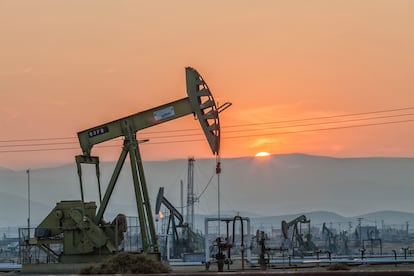The energy transition, $100 oil and a geopolitical chess match
OPEC is keeping the price per barrel artificially high while the forecast of lower demand in the future is conditioning new investments

The economy is fraught with headaches. The pandemic has ended. The problems Western Europe faced due to gas shortages in the winter of 2022-2023 have been contained. Now, stubborn inflation persists because of oil prices. It is not the Russian invasion of Ukraine that has raised oil prices, but the OPEC production cuts, led and expanded by Vladimir Putin and Mohamed bin-Salman.
Brent is approaching the psychological peak of $100 per barrel and economists are adjusting their forecasts for 2024: inflation is expected to rise, and growth is anticipated to fall. Although oil’s importance in economies is no longer what it was decades ago, energy imports continue to be a burden for Western economies. In 2023, world oil demand surpassed the pre-pandemic record. In other words, we are burning more oil than ever before.
This month, the president of the International Energy Agency predicted that oil demand will peak during this decade (last year he expected it to be by 2030). Strong investment by China and Western economies in electric vehicles and renewable energy generation supports these estimates, which create a new dilemma for the oil sector. Until now, the market has tended to balance itself: price increases above a certain level reduce demand and encourage the exploration of new wells where it is more expensive to drill, raising supply and blowing up the myth of peak oil. That happened in 2008 with the oil record, followed by the feverish growth of unconventional production in the US and Canada, which doubled in the 2010s.
This week, Zhou Xinhuai, CEO of China’s state-owned oil company CNOOC, predicted that demand in the second half of 2023 will be weaker than in the first half and said that Chinese oil demand may peak this year. That country alone has generated half of the increase in global oil demand over the last quarter-century. In its annual outlook report, BP says that oil demand will remain at around 100 million barrels per day until 2025; after that, there are several possible scenarios: high demand until 2030 with modest reductions or a sharper decline. Nevertheless, even in the boldest scenario, oil will continue to play a key role in economies beyond 2040.
This situation creates a difficult dilemma. Cutting production to keep prices high protects the oil revenues of OPEC countries, but the outlook of low demand may restrict the companies’ appetite for investment, especially with respect to opening new wells, because they need medium- and long-term signals to cover start-up and extraction costs (cheap wells have already been exploited).
OPEC will proceed based on these premises, “lower[ing] its output over the first decade of the outlook in response to the growth in US and other non-OPEC supplies, accepting a lower market share to mitigate the downward pressure on prices,” says BP. After that, however, it will recover ground; amid falling demand, non-competitive wells will be shut down first, that is, the non-conventional fields in the US and non-OPEC producers, according to the oil company, whose projections are broadly consistent with those of the IEA. Thus, the cartel’s market share will rise to 50% and 65% by 2050, up from just over 30% today, BP says.
For their part, Western economies want to and must become less carbon intensive, with the goal of reaching net zero emissions by 2050.... But in the meantime, they will need to import a lot of oil, in a contradiction similar to the paradox of the Russian gas for which we don’t want to pay Vladimir Putin but also need to heat ourselves as we seek alternatives. “Governments are rightly concerned about energy security, but new conventional field approvals cannot provide immediate relief for tight markets and may well make the later stages of the transition even more challenging,” the IEA asserts. According to the agency’s data, the new exploration permits approved in the world since the invasion of Ukraine do not compensate for the loss of Russian production. For its part, the industry can cling to this same need for energy security resulting from the war in Ukraine as a safeguard for the coming years, while benefiting from the tailwind of production cuts.
In short, decarbonization is not going to clear up the energy landscape in the short term. On the contrary, it opens up exclusively economic dilemmas (whether to invest in fields or not) that overlap and interrelate with both international geopolitics, which determines the prices and supply of fossil fuels, and domestic politics.
If the impasse period is fraught with difficulties, the way to reduce risks is to accelerate the energy transition without losing sight of these two geopolitical aspects. China is betting that electrifying the vehicle fleet and generating electricity with renewable energies will both reduce emissions and protect it from external dependence. The country’s high use of coal suggests that the latter is the primary objective.
For the record, the IEA has searched for analogous situations where such significant investment has been required: the 70% annual increase in electric car battery production (2010-2020) is second only to the rise in aircraft production in the US between 1939 and 1944. The example “suggests that even faster deployment could be achieved through more research and development (R&D) funding and more concerted government action.” In other words, we have the economic and technical capability to get to net zero. Whether we have the political will remains to be seen.
Sign up for our weekly newsletter to get more English-language news coverage from EL PAÍS USA Edition
Tu suscripción se está usando en otro dispositivo
¿Quieres añadir otro usuario a tu suscripción?
Si continúas leyendo en este dispositivo, no se podrá leer en el otro.
FlechaTu suscripción se está usando en otro dispositivo y solo puedes acceder a EL PAÍS desde un dispositivo a la vez.
Si quieres compartir tu cuenta, cambia tu suscripción a la modalidad Premium, así podrás añadir otro usuario. Cada uno accederá con su propia cuenta de email, lo que os permitirá personalizar vuestra experiencia en EL PAÍS.
¿Tienes una suscripción de empresa? Accede aquí para contratar más cuentas.
En el caso de no saber quién está usando tu cuenta, te recomendamos cambiar tu contraseña aquí.
Si decides continuar compartiendo tu cuenta, este mensaje se mostrará en tu dispositivo y en el de la otra persona que está usando tu cuenta de forma indefinida, afectando a tu experiencia de lectura. Puedes consultar aquí los términos y condiciones de la suscripción digital.
More information
Archived In
Últimas noticias
Most viewed
- Oona Chaplin: ‘I told James Cameron that I was living in a treehouse and starting a permaculture project with a friend’
- Sinaloa Cartel war is taking its toll on Los Chapitos
- Reinhard Genzel, Nobel laureate in physics: ‘One-minute videos will never give you the truth’
- Why the price of coffee has skyrocketed: from Brazilian plantations to specialty coffee houses
- Silver prices are going crazy: This is what’s fueling the rally











































